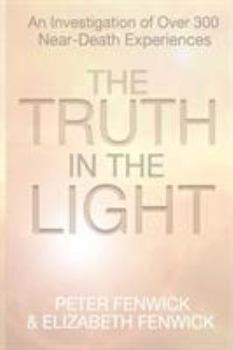The Truth in the Light: An Investigation of Over 300 Near-Death Experiences
Select Format
Select Condition 
Book Overview
Containing over 300 accounts of near-death experiences from those who have glimpsed beyond the physical boundaries of our world. Through the authors' experiences, this compelling investigation... This description may be from another edition of this product.
Format:Paperback
Language:English
ISBN:190873308X
ISBN13:9781908733085
Release Date:January 2012
Publisher:White Crow Books
Length:318 Pages
Weight:0.93 lbs.
Dimensions:0.7" x 6.0" x 9.0"
Customer Reviews
3 ratings
solid and much under-read study of NDEs
Published by Thriftbooks.com User , 14 years ago
This is an example of a doctor-authored book on the subject of the near death experience the way it should be done. The technique, as with other books of this kind, is to solicit volunteered reports. Clearly this method has serious limitations and you want to take care to make sure that what you can legitimately claim matches up with your research method. Fenwick achieves this well. Probably the most interesting part of the book is when Dr Fenwick brings his neuropsychiatrist expertise to the subject areas of anoxia and memory. The question of how NDErs manage to "remember" their experiences when the brain has just recovered from a profound trauma is an important one, as it is very common for experiences immediately preceding such a trauma to be forgotten altogether. Another really interesting factor thrown up by this study was the substantial difference in the frequency of so called "life reviews" between American cases and the UK based research sample of the author. The UK study turned up VERY few such reviews of the dramatic and detailed kind populating the American cases. This strongly suggests that there is something about the American psyche which lends itself to that component. This seems to be borne out to some degree when considering the American fascination with psychotherapy and analysis of almost infinite variation, something that your average brit (rightly or wrongly) is much more likely to look upon with scorn. This seems unlikely to be a coincidence, though, certainly, it would need a further study of some kind to actually establish that as the cause. One way or another, this seems a fairly essential difference between the American and UK cases. Yet another interesting feature of the book is the Indian cases included, although these are snatched from another study elsewhere. The case of Durga Jatav for instance, who was dragged away (in the experience) in front of the judge of the dead, where his legs were "cut off at the knees". When you read these accounts, it is glaringly obvious that there is no single worldwide thing called a "near death experience" as some people believe. Rather, what exists is a loosely collected bunch of very approximately similar experiences once you peel away all the layers of cultural imagery (in the Indian cases, for instance, at least in the studies described here, that imagery revolves around the gods of the dead and "clerical errors". In the West the imagery revolves around "dead relatives" and many more meetings with a Christian-style god of light as opposed to the leg-amputating Yama and his henchmen. A very good study that covers a lot of interesting ground. The next stage is to ask whether people who perceive themselves to be out of body really are out of body, and whether people remembering events, especially as influencing the lives of others, are remembering these correctly. At some point this subject has to emerge from the protective shelter of anecdote.
No nonsense approach to NDE
Published by Thriftbooks.com User , 16 years ago
A no-nonsense, scientific analysis of the phenomenon of Near Death Experiences. Written from a skeptical point of view, leaving the reader to make their own conclusions on if this phenomenon is a glimpse into the afterlife or something that science can explain. Scientific explanations are given for accounts of NDE, yet there is still, admitted by the skeptical author, aspects of NDE that not even science can explain.
comprehensive and interesting study
Published by Thriftbooks.com User , 24 years ago
This book is a rather comprehensive study of the phenomenon known as NDE's or near-death experiences. It is written by the president of the British branch of The International Association for Near Death Studies.Many different first hand experiences are presented on people (mostly from Britain) who have had either near death, or similar non-near death experiences. The author painstakingly analyzes the similarities and differences of these experiences. He also explains in great detail the physiological and chemical (hypercarbia, endorphins, drugs, etc) similarities and differences of brain function during trauma and near death scenarios.Through all this, the author does not attempt to make a strong case for an afterlife or otherworld consciousness, but to provide as much evidence as is available to make an assessment. The author's admission is that according to science, the possibility of the soul or the continuation of personal consciousness are simply theories with little or no evidence to support them. However, he certainly doesn't rule out the possibility of an afterlife, citing many intriguing and compelling elements of the true NDE which science or hard facts cannot explain and could not really be considered "evidentiary." But one of his biggest questions is: How can knowledge and experiences exist in a spiritual world when the medium which originally stored them, the brain, is gone?These are just a few of many elements and observations which make this a fine book. It is both fascinating and challenging and is highly recommended to anyone interested in NDE's.






